Jeez hope I wasn't misunderstood as putting down anybody's choice of rifle, would never do that. It's just that I have been considering one of these in flint, and this looked like a good place to ask for info. Neither was it my intention to hijack the thread. :surrender:
-
Friends, our 2nd Amendment rights are always under attack and the NRA has been a constant for decades in helping fight that fight.
We have partnered with the NRA to offer you a discount on membership and Muzzleloading Forum gets a small percentage too of each membership, so you are supporting both the NRA and us.
Use this link to sign up please; https://membership.nra.org/recruiters/join/XR045103
You are using an out of date browser. It may not display this or other websites correctly.
You should upgrade or use an alternative browser.
You should upgrade or use an alternative browser.
GPR how close to a original
- Thread starter rem700
- Start date

Help Support Muzzleloading Forum:
This site may earn a commission from merchant affiliate
links, including eBay, Amazon, and others.
For what it's worth, I've heard that Lyman frizzens are among the better production frizzens available. I've heard somewhere of owners of another brand ending up replacing theirs with Lyman frizzens (likely having to modify them somewhat to get them to work). This is all secondhand information, at best.
There is nothing wrong with a GPR. I started out with one many years ago. They are a quality rifle, they just don't look anything like any original Hawken I have ever seen. I'm certainly not an expert, but I have handled about a dozen original Hawkens, over the years.
Not only is the GPR barrel too small in diameter, it's too short. The barrels on all of the Hawkens I have seen are longer. Barrel lengths on originals typically range from 33" to about 38". All I have handled had tapered barrels, with the exception of a very delicate squirrel rifle with a slightly swamped barrel.
The tang on the GPR is waaaayyy too short. The tang illustrated in Cooner's photo is typical of the Hawken style tang.
The GPR stock is too delicate to replicate a Hawken, the architecture isn't right, and as mentioned, the buttplate isn't quite right.
That said, there is nothing wrong with the GPR, they are good shooters, they just are nothing like an original Hawken.
Ya gotta remember the old mountain men traveled by horseback, so the weight of the rifle wasn't a big issue. Weight is an issue when carrying a rifle up and down hills and hollers and through the brush,
and I don't think I would want to carry a rifle as heavy as a real Hawken all day.
lspmmp,
I don't uderstand your complaint about someone wanting an accurate copy of an original rifle. Would a copy be a "Hawken", not in the sense it was made by the Hawken Bros, but in the sense that it would be a true to life copy. Nothing wrong with that. IMHO, it's better to know what a original Hawken rifle looks and feels like through a true to life copy than continue to be misinformed.
J.D.
Not only is the GPR barrel too small in diameter, it's too short. The barrels on all of the Hawkens I have seen are longer. Barrel lengths on originals typically range from 33" to about 38". All I have handled had tapered barrels, with the exception of a very delicate squirrel rifle with a slightly swamped barrel.
The tang on the GPR is waaaayyy too short. The tang illustrated in Cooner's photo is typical of the Hawken style tang.
The GPR stock is too delicate to replicate a Hawken, the architecture isn't right, and as mentioned, the buttplate isn't quite right.
That said, there is nothing wrong with the GPR, they are good shooters, they just are nothing like an original Hawken.
Ya gotta remember the old mountain men traveled by horseback, so the weight of the rifle wasn't a big issue. Weight is an issue when carrying a rifle up and down hills and hollers and through the brush,
and I don't think I would want to carry a rifle as heavy as a real Hawken all day.
lspmmp,
I don't uderstand your complaint about someone wanting an accurate copy of an original rifle. Would a copy be a "Hawken", not in the sense it was made by the Hawken Bros, but in the sense that it would be a true to life copy. Nothing wrong with that. IMHO, it's better to know what a original Hawken rifle looks and feels like through a true to life copy than continue to be misinformed.
J.D.
Sorry I didnt mean to start a feud please forgive a greenhorns terminology, :surrender: I guess I miss used Hawken as a generic word for Plains or Mountain style of rifle. Perhaps asked a different way would the GPR be a fair representative of the plains style rifle of the era or acceptable at smaller BP shoots.
Guest
Rem700,
To some, ignorance is bliss. I don't want to ruin anyone's blissfulness if they are comfortable there.
In your question though, I sense an eagerness to learn more about what a Hawken or a good Hawken copy should be. I intend to help you and anyone else interested to see the details that are common on a Hawken and any plains rifle as far as good architecture goes.
Another problem area that I would like to point to is the wrist area coming back off of the top barrel flat towards the comb. Many leave to much wood where the lock panels sweep into the wrist. The wrist should look like it is a tube shaped like an oval in cross section going up beyond the panels. This creates a shallow groove above the panels and takes out the extra wood from that area. Hopefully you can see it here. You can see it a little better in the pic I posted in the previous post. You can also see how the panels taper back towards the wrist.
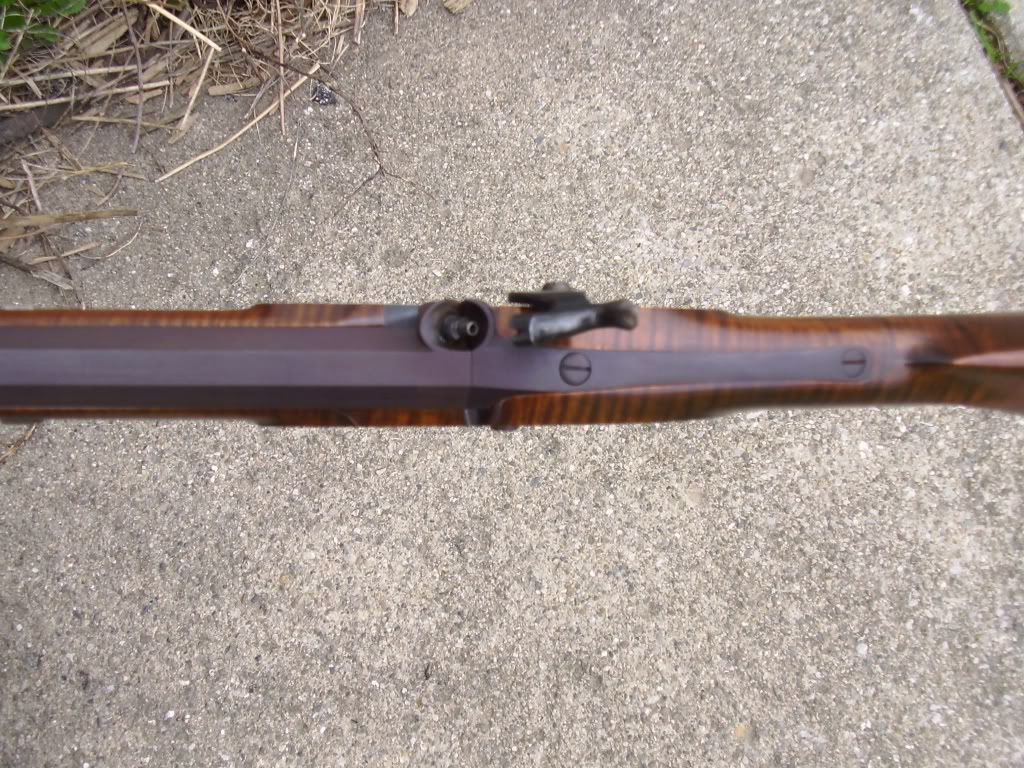
Sure there was differences in original Hawken rifles but don't let any one fool you into thinking that just anything goes for good Hawken architecture. These next two pics should give you a better idea of how the lock panels are distinctly separate from the wrist. There is no gradual flow as in machine made stocks. Take this extra wood off with a small half round rasp and keep the lines of the wrist smooth and straight longitudinally but ovoid in cross section. Flat on the bottom of course. The flat that the trigger bar sets in should only be about 1/16" th inch wider than the trigger bars on each side. Most factory rifles are much to wide there.
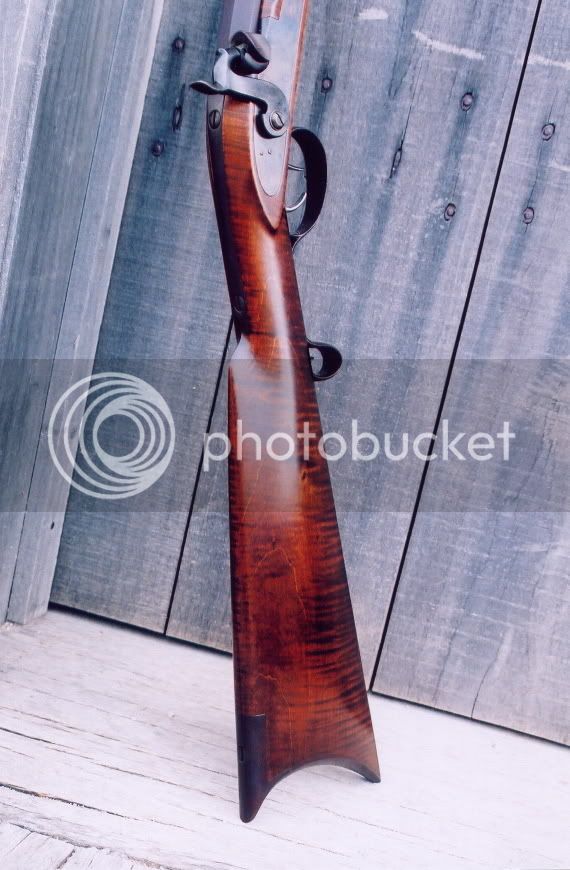
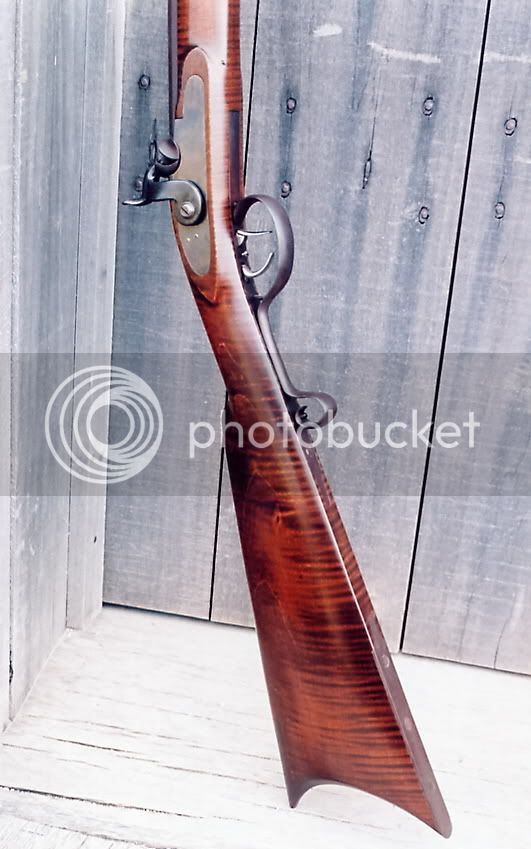
To some, ignorance is bliss. I don't want to ruin anyone's blissfulness if they are comfortable there.
In your question though, I sense an eagerness to learn more about what a Hawken or a good Hawken copy should be. I intend to help you and anyone else interested to see the details that are common on a Hawken and any plains rifle as far as good architecture goes.
Another problem area that I would like to point to is the wrist area coming back off of the top barrel flat towards the comb. Many leave to much wood where the lock panels sweep into the wrist. The wrist should look like it is a tube shaped like an oval in cross section going up beyond the panels. This creates a shallow groove above the panels and takes out the extra wood from that area. Hopefully you can see it here. You can see it a little better in the pic I posted in the previous post. You can also see how the panels taper back towards the wrist.

Sure there was differences in original Hawken rifles but don't let any one fool you into thinking that just anything goes for good Hawken architecture. These next two pics should give you a better idea of how the lock panels are distinctly separate from the wrist. There is no gradual flow as in machine made stocks. Take this extra wood off with a small half round rasp and keep the lines of the wrist smooth and straight longitudinally but ovoid in cross section. Flat on the bottom of course. The flat that the trigger bar sets in should only be about 1/16" th inch wider than the trigger bars on each side. Most factory rifles are much to wide there.


Guest
BTW, the shape of the lock panels in the above post are 1840's and earlier. This next pic is a side view of the early panels. Look at how the panels sweep up just in front of the lock plate.
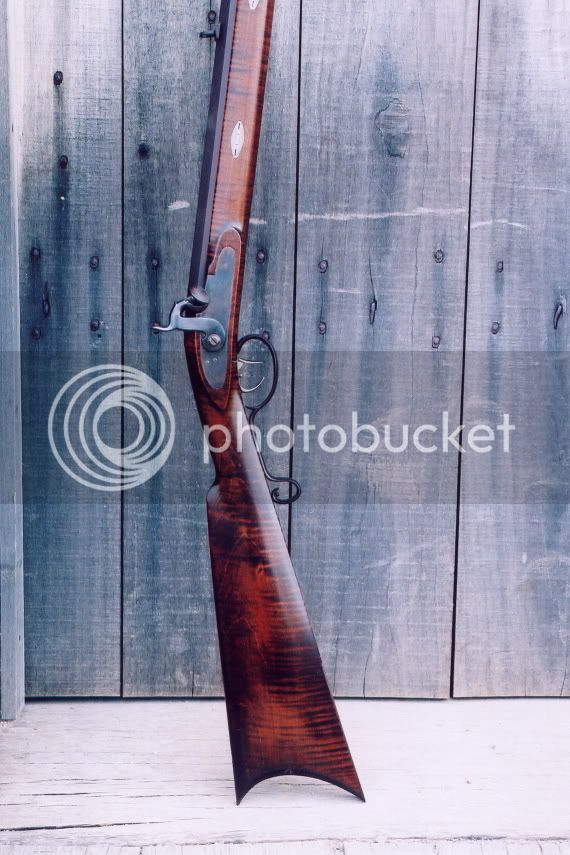
Later Hawken rifles such as the GPR is supposed to represent looks like this on original Hawken rifles. See below.
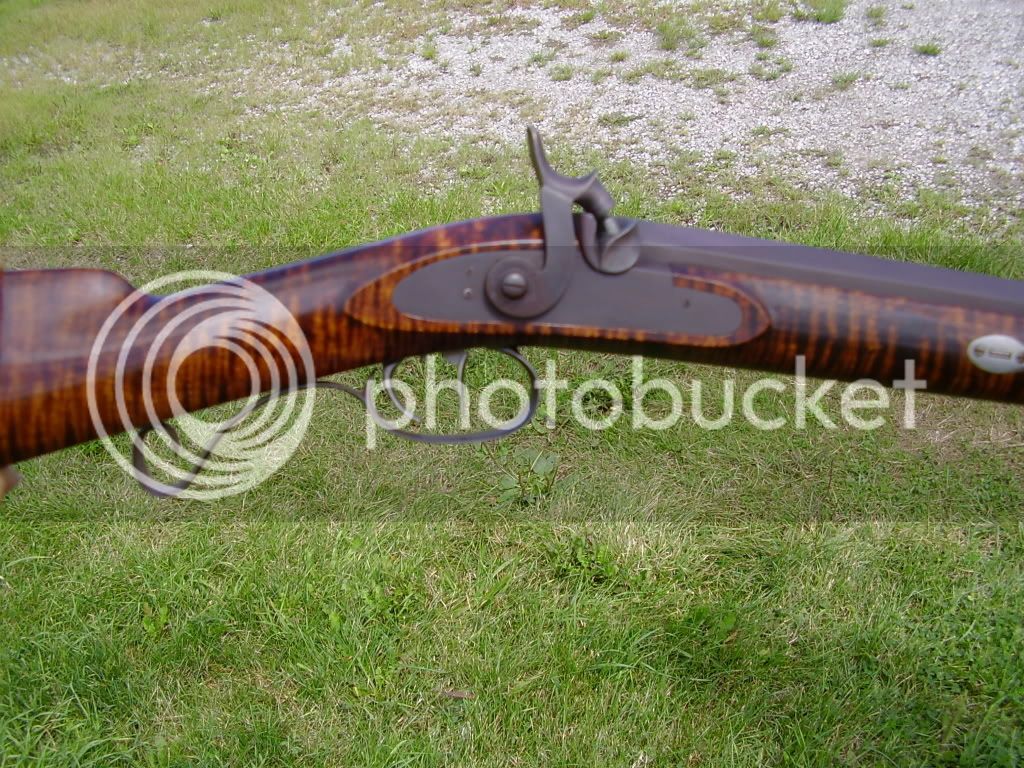
The panel actually flows right into the lock plate and the lock plate is filed to match the panel edge.

Later Hawken rifles such as the GPR is supposed to represent looks like this on original Hawken rifles. See below.

The panel actually flows right into the lock plate and the lock plate is filed to match the panel edge.
As has been said before a pic is worth a 1000 words. Pointing out the nuances helps alot went someone is new and dont know what they are looking for to begin with. And as has been pointed out earlier now that I know what I am looking for I can see where the tang comes almost back to the start of the comb. A Hawken it will never be but with alot of pics and guidance it should look alot better then a out of the box GPR with luck perhaps somewhere between a sows ear and a silk purse.
Guest
Rem, as I said in my first post, you can still make a great Plains rifle out of your GPR. It won't be a Hawken but it will be a Plains rifle. The architectural details that I have pointed out above are just good rifle architectural details found commonly on halfstock plains rifles of the 19th century by many makers. Good luck in your efforts and if you have any questions, please PT me. I am more than glad to help another craftsman. :hatsoff:
A craftsman I am not. I will not start project for another month or so for now it is just info gathering ideas and decisions before I start. In another month deer season will be over and I will have a long Minnesota winter to devote to this project.
Your Sante Fe looks a twin to that one ??? Boy did I get Robbed and I got a NEW 1985 one never shoot. Fred :hatsoff: Lets see Bairds other book, why we skiped that one..? " In the Hawken Load" and hers a few pics of my SF (I hope[url] http://www.muzzleloadingforum.com/fusionbb/showtopic.php?tid/191951/tp/4/[/url] .and a another
Last edited by a moderator:
Or maybe it was here..[url] http://www.muzzleloadingforum....php?tid/190140/post/228271/hl//fromsearch/1/[/url] Fred :hatsoff: From our 3 set Hawken "pages Claude let us get away with for sometime.. :hatsoff:
Last edited by a moderator:
One of the subtlies of a well made Hawken is illustrated in Cooners second and third photo in the message at the top of the page.
Notice how the reflection highlights the thicker, center portion of the butt.
The butt stock is thinner at the heal and toe of the butt than in the center.
Notice how the reflection highlights the thicker, center portion of the butt.
The butt stock is thinner at the heal and toe of the butt than in the center.
Guest
JD is correct, especially on the late Hawkens. Another thing that will help on your factory rifles is to shape your snail like this instead of leaving them as cast which is what I see on factory rifles. Use a triangle file in front and behind the nipple seat so the nipple seat is oval shaped.

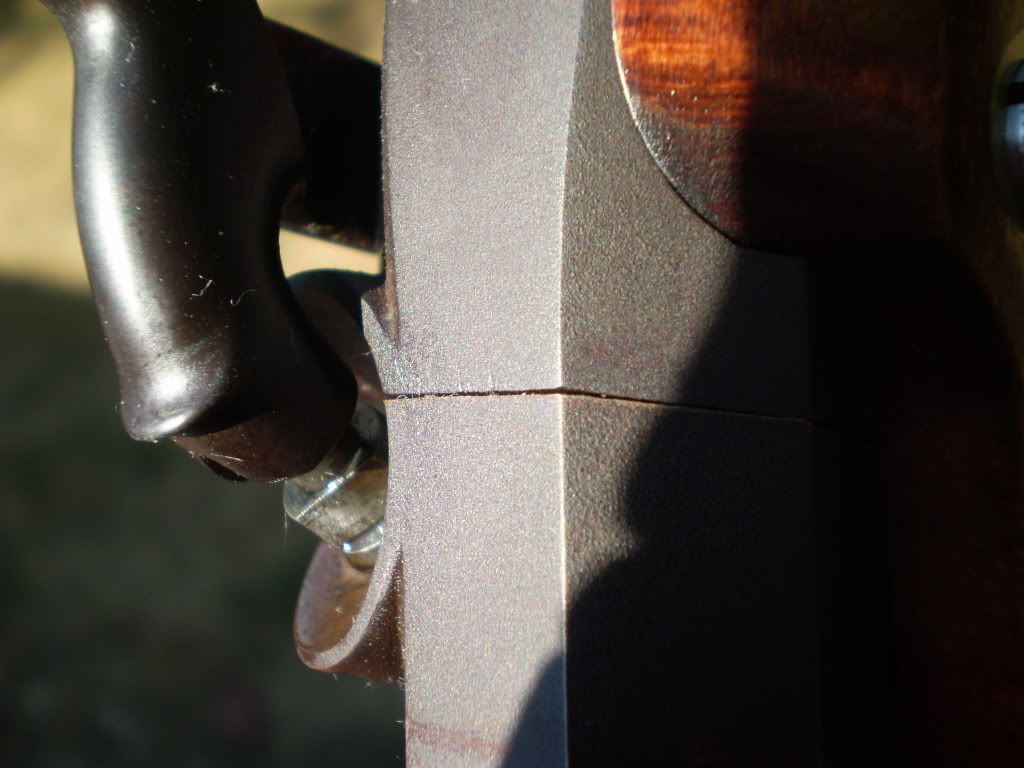


Guest
Also, the Hawken ribs had a halfmoon solder fill at the muzzle end. I have seen this on other makes of Plains rifles as well.

I do this with a round chain saw file. Flux the inside of the halfmoon shape after it is mounted to the barrel and fill it up with soft solder.

I do this with a round chain saw file. Flux the inside of the halfmoon shape after it is mounted to the barrel and fill it up with soft solder.
But they both have tiggers and barrels right Cooner? :wink: most outstanding to me is the wood flair on sides of the lock area, have you shown that one yet?? Ya got to face it when these guys (Hawken Bro's put togehe a ifle its not something someone would of wanted to copy way back when and expect to get it right. Heck so few can do it now with power tools and E lec tris tey! :rotf: makes me wonder how they did i then. Fred :hatsoff:
Cooner: Mercy sakes that's a pretty Hawken ...
Similar threads
- Replies
- 2
- Views
- 434



